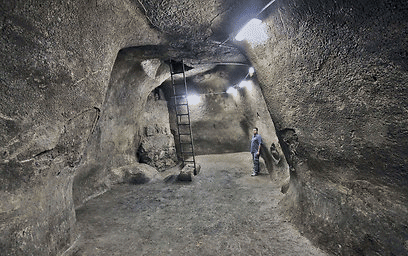Archaeological Discoveries: Massive First Temple-Period Reservoir Discovered Under Western Wall
(September 2012)
A large rock-hewn water reservoir dating to the First Temple period was discovered in archaeological excavations being conducted in the Jerusalem Archaeological Garden at the foot of Robinson’s Arch near the Western Wall in Jerusalem's Old City.
When a floor from an underground drainage ditch collapsed, archaeologists were amazed to find a massive water reservoir measuring 12 meters by 5 meters by 4.5 meters that could hold approximately 250 cubic meters of water. The reservoir, roughly one-tenth the size of an Olympic swimming pool, is incredibly significant because it is the first evidence of stored water next to the Temple. Previously, experts believed that pilgrims and residents used to hike to the Gihon Spring – located in a wadi at the bottom of the City of David park – in order to get water for rituals and daily life around the First Temple.
Chief archaeologist Eli Shukron said, "While excavating beneath the floor of the drainage channel a small breach in the bedrock was revealed that led us to the large water reservoir. To the best of our knowledge this is the first time that a water reservoir of this kind has been exposed in an archaeological excavation ... [The finding] gives us an opportunity to understand their day-to-day life." Shukron is fairly certain that the pool was a public reservoir because the private wells could only hold a few dozen cubic meters of water.
According to Dr. Tvika Tsuk, chief archaeologist of the Nature and Parks Authority and an expert on ancient water systems, "The large water reservoir that was exposed, with two other cisterns nearby, is similar in its general shape and in the kind of plaster to the light yellow plaster that characterized the First Temple period and resembles the ancient water system that was previously exposed at Beit Shemesh ... Presumably the large water reservoir, which is situated near the Temple Mount, was used for the everyday activities of the Temple Mount itself and also by the pilgrims who went up to the Temple and required water for bathing and drinking."
The reservoir’s discovery was presented at the 13th annual City of David Studies of Ancient Jerusalem conference which deals with findings from the past year in the City of David archeological park.
Sources: Melanie Lidman, "Massive Resevoir Discovered Beneath Western Wall," Jerusalem Post, (September 6, 2012).
YnetNews, "Public Water Resevoir Exposed Near Western Wall," Ynet, (September 7, 2012).
Photo Courtesy of the Israel Antiquities Authority



